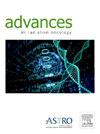基于人工智能的风险器官自动分类对中低收入国家的影响
IF 2.7
Q3 ONCOLOGY
引用次数: 0
摘要
目的 放射治疗(RT)过程需要大量的人力资源和专业知识,这对中低收入国家(LMIC)快速部署 RT 造成了障碍。准确分割肿瘤靶点和高危器官(OAR)对于优化 RT 至关重要。本研究评估了基于人工智能(AI)的自动分割 OARs 对 2 个低收入和中等收入国家的影响。方法和材料随机选取 10 名患者,包括 5 名头颈部癌症患者和 5 名前列腺癌患者。使用食品药品管理局批准的人工智能软件工具对规划计算机断层扫描图像进行自动分割,并由来自 2 个低收入国家 RT 诊所的经验丰富的放射肿瘤专家进行手动分割。对照数据来自美国的一家大型学术机构,由一名经验丰富的放射肿瘤专家获得。对分割时间、DICE 相似性系数(DSC)、Hausdorff 距离和平均表面距离进行了评估。结果 人工智能大大缩短了分割时间,平均每名患者只需 2 分钟,而在低收入国家,人工轮廓制作需要 57 到 84 分钟。与对照数据相比,人工智能骨盆轮廓的一致性优于低收入国家的人工轮廓(低收入国家 1 的平均 DSC 为 0.834 vs 0.807,低收入国家 2 的平均 DSC 为 0.844 vs 0.801)。在 HN 等值线方面,在 LMIC1(平均 DSC:0.823 vs 0.821)或 LMIC2(平均 DSC:0.792 vs 0.748),人工智能在大多数 OAR 等值线方面比人工等值线提供了更好的一致性。结论 基于人工智能的自动分割技术可为低收入国家的骨盆癌和乳头状瘤癌症患者生成与人工分割质量相当的 OAR 轮廓,并可节省大量时间。本文章由计算机程序翻译,如有差异,请以英文原文为准。
Impact of Artificial Intelligence-Based Autosegmentation of Organs at Risk in Low- and Middle-Income Countries
Purpose
Radiation therapy (RT) processes require significant human resources and expertise, creating a barrier to rapid RT deployment in low- and middle-income countries (LMICs). Accurate segmentation of tumor targets and organs at risk (OARs) is crucial for optimal RT. This study assessed the impact of artificial intelligence (AI)-based autosegmentation of OARs in 2 LMICs.
Methods and Materials
Ten patients, comprising 5 head and neck (HN) cancer patients and 5 prostate cancer patients, were randomly selected. Planning computed tomography images were subjected to autosegmentation using an Food and Drug Administration-approved AI software tool and manual segmentation by experienced radiation oncologists from 2 LMIC RT clinics. The control data, obtained from a large academic institution in the United States, consisted of contours obtained by an experienced radiation oncologist. The segmentation time, DICE similarity coefficient (DSC), Hausdorff distance, and mean surface distance were evaluated.
Results
AI significantly reduced segmentation time, averaging 2 minutes per patient, compared with 57 to 84 minutes for manual contouring in LMICs. Compared with the control data, the AI pelvic contours provided better agreement than did the LMIC manual contours (mean DSC of 0.834 vs 0.807 in LMIC1 and 0.844 vs 0.801 in LMIC2). For HN contours, AI provided better agreement for the majority of OAR contours than manual contours in LMIC1 (mean DSC: 0.823 vs 0.821) or LMIC2 (mean DSC: 0.792 vs 0.748). Neither the AI nor LMIC manual contours had good agreement with the control data (DSC < 0.600) for the optic nerves, chiasm, and cochlea.
Conclusions
AI-based autosegmentation generates OAR contours of comparable quality to manual segmentation for both pelvic and HN cancer patients in LMICs, with substantial time savings.
求助全文
通过发布文献求助,成功后即可免费获取论文全文。
去求助
来源期刊

Advances in Radiation Oncology
Medicine-Radiology, Nuclear Medicine and Imaging
CiteScore
4.60
自引率
4.30%
发文量
208
审稿时长
98 days
期刊介绍:
The purpose of Advances is to provide information for clinicians who use radiation therapy by publishing: Clinical trial reports and reanalyses. Basic science original reports. Manuscripts examining health services research, comparative and cost effectiveness research, and systematic reviews. Case reports documenting unusual problems and solutions. High quality multi and single institutional series, as well as other novel retrospective hypothesis generating series. Timely critical reviews on important topics in radiation oncology, such as side effects. Articles reporting the natural history of disease and patterns of failure, particularly as they relate to treatment volume delineation. Articles on safety and quality in radiation therapy. Essays on clinical experience. Articles on practice transformation in radiation oncology, in particular: Aspects of health policy that may impact the future practice of radiation oncology. How information technology, such as data analytics and systems innovations, will change radiation oncology practice. Articles on imaging as they relate to radiation therapy treatment.
 求助内容:
求助内容: 应助结果提醒方式:
应助结果提醒方式:


